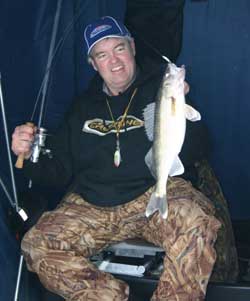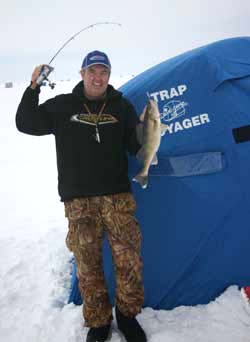 There’s nothing like the feeling you get when you stick a big walleye in deep water and it can really be exciting. First you see it, then you entice it, then you hook it, and then you hope like heck that you can work it to the top and get it through the hole, or at least get it close enough to get a good look. The whole process is exhilarating and makes the work of finding the right spot, being there at the right time, and using the right bait all worthwhile. It also gives you some well earned bragging rights (not that you should use them) and can make for a memorable trip.
There’s nothing like the feeling you get when you stick a big walleye in deep water and it can really be exciting. First you see it, then you entice it, then you hook it, and then you hope like heck that you can work it to the top and get it through the hole, or at least get it close enough to get a good look. The whole process is exhilarating and makes the work of finding the right spot, being there at the right time, and using the right bait all worthwhile. It also gives you some well earned bragging rights (not that you should use them) and can make for a memorable trip.
Although you might think it’s a matter of luck, it really isn’t, at least not all of it. Putting together the big fish puzzle is more a matter of understanding seasonal walleyes movements, their basic needs, and maybe outwitting your competition. Outwitting your competition is often a matter of simply beating them to the punch, and getting your baits in front of fish that have yet to see a lure.
Fast breaks and drop offs is where a lot of the mid winter walleye action takes place and includes offshore structure like underwater bars and humps. Bigger structures have a better chance of holding major schools of active walleyes but are likely to receive most of the pressure, while smaller bars and humps may be overlooked by the crowds and can continue to give up the goods long after the more popular spots have completely shut down. With that in mind it would be a good idea to take advantage of the community holes first, and then make a move to the smaller less obvious spots when things slow down.
Getting your hands on a good map is one of the keys to finding off shore structure quickly, and there is now some extremely accurate maps available to today’s angler. Navionics for example, has re-surveyed hundreds of lakes and the new information has revealed a wealth of information including newly discovered structure that is displayed with incredible detail. The little known out of the way spots are now out in the open everyone to see, to the dismay of some and the approval of many. Like it or not it’s here to stay so you might as well use it to your advantage.
With a Navionics data card and a GPS with a plotter like the Humminbird Matrix 97 you can display the detailed information and exactly where you are in relation to it all. In years past I’ve used a handheld to help find my spots but it really hasn’t been practical or safe, especially when I’ve had to run long distances. This season there will be a full sized GPS with a 5.6" screen mounted on the dash of my ice fishing sled, which will be much easier see and I’ll be able to keep both hands on the handle bars where they belong.
 Once you’ve located a potential hot spot you can actually draw it out, if you have the aforementioned equipment and a little snow. Ron Westberg actually does the mapping for Navionics and used what he had uncovered to find offshore structure last winter: "We were looking for a deep hump on Winnibigoshish in northern Minnesota and used the "map" and a GPS to find it. Once we got there we ran the edges with a sled at a specific depth and were able to trace the shape of the hump in the snow. We then concentrated our time on those edges and were able to put together a nice bunch of walleyes."
Once you’ve located a potential hot spot you can actually draw it out, if you have the aforementioned equipment and a little snow. Ron Westberg actually does the mapping for Navionics and used what he had uncovered to find offshore structure last winter: "We were looking for a deep hump on Winnibigoshish in northern Minnesota and used the "map" and a GPS to find it. Once we got there we ran the edges with a sled at a specific depth and were able to trace the shape of the hump in the snow. We then concentrated our time on those edges and were able to put together a nice bunch of walleyes."
Edges are often the key to finding numbers of fish, but now always the answer to finding the real monsters. It’s always a good idea to start with an edge, but don’t be afraid to move right up on top, or even down and off the base of a break. Bigger walleyes are often loners and although they maybe holding close to the big schools, they might not be directly amongst them.
A good plan of attack would include spooning the edges, and then setting out tip ups where there’s a chance ol’ marble eyes might show up. The idea is to mix it up and try to cover as much ground as you can. With a spoon and a fish finder like the new Marcum LX-5 you’ll soon see if you’re in the right spot or not, at least for the numbers. The LX-5 has a new screen that makes daytime viewing in direct sun a whole lot easier and is a tremendous improvement. Drop a spoon like a Northland Tackle Buck-Shot Rattle tipped with a minnow head down the hole and watch the depth finder. By snapping the bait up and then letting it come to rest you should be able to attract at least a few lookers, if there are any fish in the neighborhood. If not; keep moving and trying new holes until you start to see fish. If you’re seeing fish it’s time to settle in for a bit and drop down a set rig under a float on another rig, or maybe set out a tip up. While the spoon can draw them in, they might be looking for something more sedentary to gobble up.
If you’re going to get serious about finding mid winter walleyes you better be prepared. For one thing; don’t go alone, especially if you’re traveling miles off shore. You never know what kind of trouble you can get in and you better have some help along in case things go bad. For another; you better be dressed for the occasion. I had the chance to use Clam Corp’s new Ice Armour suit last season and found it to be surprisingly warm, even in the most severe conditions. The Ice Armour suit totally shuts out the wind, is completely waterproof, and even has padded knees which helps to keep you warm when you’re down on the ice clearing holes, or checking depths, or maybe picking up a tip-up that has tripped. See you on the ice.










